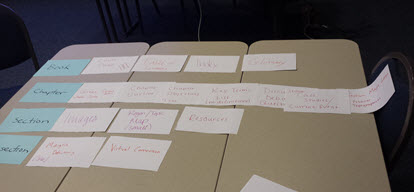16
After you have created a general outline for your book structure (in the previous chapter), look to the common elements within that structure. Elements, just as structural components, should be fairly consistent throughout your book.
It is at this point when you might start to look for matches among existing content. For example, do you have a case study that can be used for each unit or chapter you are creating? If you only have one case study you intend to use, can it become a chapter in itself? Does it belong in the appendices? As you build your elements, you may find that your overarching structure is modified as well.
This list is meant to assist in the process of creating your elements. It is in no way exhaustive and many categories of content may be repeated with different terminology.
Elements
- Headings
- Titles
- Objectives
- Overview
- Introduction
- Body
- Graphs
- Images
- Tables
- Maps
- Sidebar
- Key Terms
- Vocabulary Terms
- Practice Questions
- Example Sets
- Answer Keys
- Key Takeaways
- Summary
- Conclusion
- Case Studies
- Quiz

